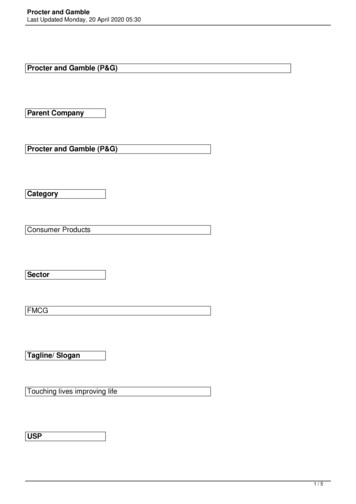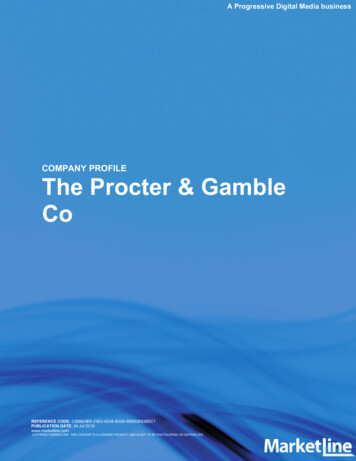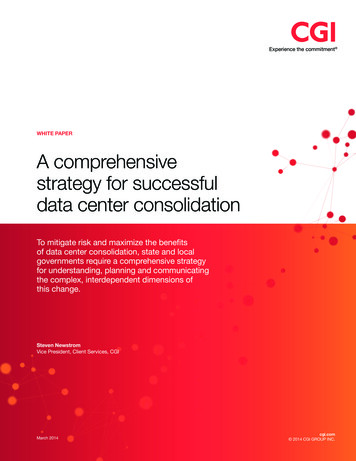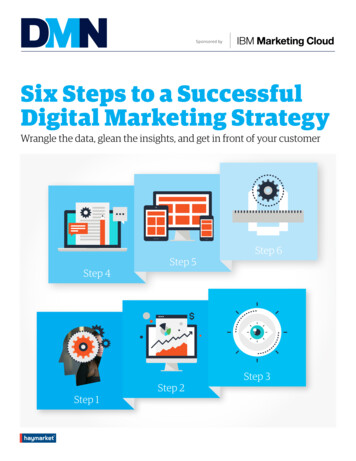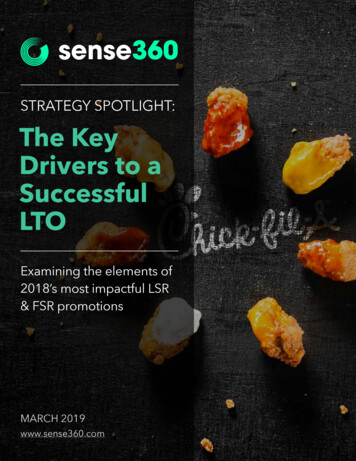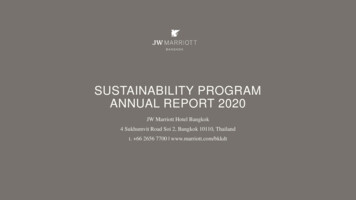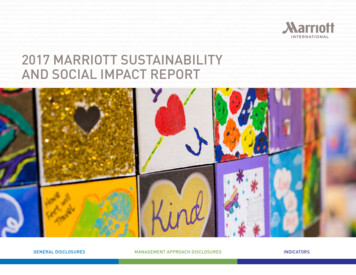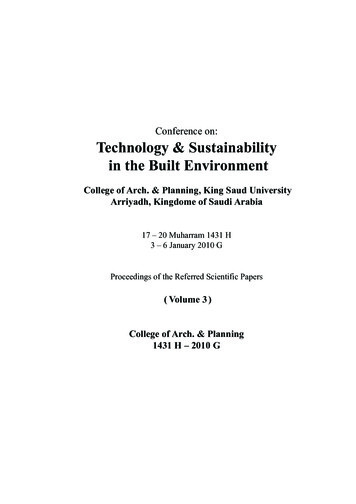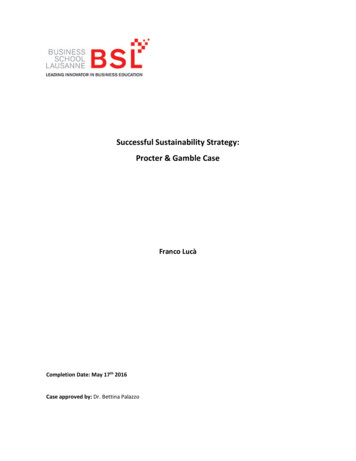
Transcription
Successful Sustainability Strategy:Procter & Gamble CaseFranco LucàCompletion Date: May 17th 2016Case approved by: Dr. Bettina Palazzo
EXECUTIVE SUMMARYThis case study examines Procter & Gamble’s (P&G’s) journey towards true sustainability. P&G isrecognised and verified as a strong sustainability player and has received several certifications byindependent organisations in the field of corporate sustainability. Furthermore, the company is workingtowards its long-term 2020 vision and pursuing significant initiatives in addressing social and environmentalissues while successfully fulfilling its economic goals. Based on these parameters, P&G was chosen duringthe research process as a partner for this case study. This case study will reflect how an organisation makesprogress and adapts during the challenging path towards sustainable development.The case study explores the historical timeline of P&G to evaluate the progress made in the adoption ofbusiness sustainability. The second section will analyse the results from the sustainability culture andleadership assessment (SCALA) survey, which will provide the reader with the employees’ perspectivesregarding the company’s sustainability culture. The third section will synergize the data provided in the firsttwo sections and will compare the company to the Dyllick and Muff typology of sustainability (Dyllick &Muff, 2015). The story of P&G’s sustainability strategy is about change. This case study provides evidencethat to implement its strategy and achieve the level of true sustainability, P&G has to develop a sense ofurgency throughout the whole company. The main challenge in achieving true sustainability is the changeprocess. Successful sustainability change initiatives have to be driven internally.SUSTAINABILITY IN THE CONTEXT OF CHANGEFor the past 60 years, P&G has committed to creating an environment that includes social andenvironmental goals in their business conduct. Despite these consistent efforts for sustainability at P&G, in2013 and 2014, the media repeatedly reported that P&G and many other companies were sourcing palm oilfrom suppliers connected to widespread forest devastation (Greenpeace, 2014b), done to create land forpalm oil plantations. Articles with headlines like ‘P&G’s Dirty Secret’ reported that P&G’s sourcing policiesexpose its supply chain to forest fires and habitat destruction (Maitar, 2014). In 2013, Greenpeace beganinvestigating P&G’s supply chain for more than a year and found that an orangutan habitat was beingcleared in a plantation linked to P&G’s supply chain. Land used for palm oil cultivation owned by the BWPlantation Group, a company connected to P&G’s supply chain, was also linked with the deaths and burialsof orangutans next to the Tanjung Putting National Park. In other cases, Greenpeace documented ongoingforest clearance within the concessions of two producers known to be directly supplying P&G. In June 2013,more than 150 fire hotspots were recorded within these concessions. A few months later, articles, such as‘P&G Commits to Protect World’s Rainforests’, began to appear in the media (Gies, 2014). On 26 March2014, five Greenpeace volunteers presented P&G with a ‘worst-of’ award (the Golden Axe), which claimed1
that P&G was buying palm oil from companies that destroy Indonesia’s rainforests. Greenpeace presentedthe award at Europe’s biggest cosmetic and detergent convention, Cleaning Products Europe, inManchester, England. The sustainability director for P&G was addressing the industry audience, andRichard George, forests campaigner for Greenpeace UK, joined her at the podium and presented her withthe award. He said, ‘There were many companies in the running for this award, but P&G’s brazen claim thatbuying palm oil from companies that destroy the rainforest was sustainable made it the stand-out winner.That level of chutzpah needs rewarding, so we’re pleased to award Procter & Gamble with the Golden Axeaward for services to deforestation’. The conference attendees were also provided with a brochure, whichargued that, despite their protestations of sustainability and family-friendliness, P&G fuels deforestation bybuying palm oil from some of the most destructive companies in Indonesia (Greenpeace, 2014c).This case reflects the widespread effect of highly visible companies, such as P&G, promoting their activeparticipation in the sustainability movement and the difficulty of evaluating the validity of such claims. Thesourcing of palm oil is a complex topic because it has both negative and positive side effects, with a positivebeing that its economic value rescued many Indonesians from poverty. Furthermore, Greenpeace failed tounderline that, in 2013, P&G and many other companies were actively working towards 100% ‘Roundtableon Sustainable Palm Oil’ (RSPO) certification as a way to demonstrate responsible sourcing. Greenpeacefocused on their belief that RSPO certification was insufficient and pushed for specific changes to RSPO andsupplier sourcing policies. Still, P&G did make changes to their sourcing policies that aligned with therequests of Greenpeace and other non-governmental organisations (NGOs); as a consequence, by the endof March 2014, The Guardian stated that Greenpeace believed that P&G was taking steps to clean up itspalm oil sourcing practices (Hamid, 2014). In April 2014, P&G said it had eliminated deforestation from allof its palm oil sourcing practices and announced a non-deforestation policy for all of its products(Greenpeace, 2014a; Greenpeace, 2014b; Baker, 2014). In this perspective, P&G confirmed the goal ofestablishing traceability to palm oil mills by working closely with suppliers to ensure no deforestation intheir supply chain by 2020 in its Sustainability Report 2015. This goal also applies to palm kernel oilsuppliers with the aim of improving both practices and livelihoods to establish zero deforestation in theP&G supply chain by 2020. Currently, the company is under track to achieve these goals.P&G’s issues surrounding palm oil indicate that P&G has proven its ability to react and change itssustainability strategy in urgent situations. Does it suggest that nothing will change without a sense ofurgency including sustainability policy or strategy? Were Greenpeace’s claims true? In addition, does thepalm oil accusation prove that P&G has not had sustainable practices in the past? The palm oil issue facedby P&G has proven to the outside world that the company has made a big step forward in makingsustainability strategies a respected and integrated topic. This case study will investigate P&G’s2
sustainability path and further analyse the company’s current sustainability position and possibleopportunities to strengthen its sustainability practices.Purpose and objectivesThere are multiple realities inside such a complex and large organisation as P&G. In this context, ‘realities’means that according to the hierarchical level of the organisation, including the region where people areworking and the culture where they live, the way people look at a situation can vary significantly fromperson to person. As the constructivist theory (e.g. von Foerster, 2006; von Glasersfeld, 2011; Watzlawick,1995) argues, reality does not exist; rather, reality is a mental construct. Therefore, based on the varioussocialisation norms, cultures and hierarchies, people will have varied perspectives about life. This notion isimportant in the perspective of change since it presumes that a management’s decision to change may notautomatically lead to change if the employees involved in the change processes of the highest importancedo not feel the need to change.One of the most important factors for change is employee awareness towards change and their willingnessto change in order to implement P&G’s strategy. If the employees—beginning from the top management inall regions and throughout the whole value chain—do not recognise the necessity and urgency ofimplementing sustainability as part of the process or do not see sustainability as an important factor forP&G’s success, the company will not reach its goals because it will lack a basis for the new pillars. Processes,policies and structures can be changed, but to succeed, the employees have to be aware of the necessity tochange and have the willingness to live this paradigm change every day. Therefore, management has tocreate a context that empowers the employees and increases their awareness of the sustainability strategyand the urgency to change.For P&G, it means that the company must grapple with the following key question: Are our employeesaware of the necessity of becoming sustainable as a key success factor for the future of the company?Looking at the goals of the company, the management assumes that the employees are in line with theparadigm change to become more sustainable. The top management creates its own reality and, therefore,assumes that the employees share this reality. However, the employees live another reality and do notautomatically share the same perspective; the management’s perceptions, thus, often do not correspondwith what is actually happening within the company.To change the sustainability strategy the leadership has to create a context or frame that enables theemployees to become aware and sensitive to the need for change. P&G has already implemented principles,long-term goals, Key Performance Indicators (KPI) and values that help monitor and evaluate the process3
and implementation of its strategies. However, leadership and organisational culture are necessary tosupport and focus attention on those employees lacking a sense of urgency to change or those who arereluctant to change. The aim of this case study is to investigate whether the management and employeesof P&G are committed to the sustainability strategy and share the same urgency needed to successfullyimplement the change such a strategy requires. Furthermore, this case study will analyse whether the KPIsand values are properly implemented and communicated.The insights gained from this case study will be beneficial for all of P&G’s regional managers, stakeholdersand the new chief executive officer, who began working for the company on 1 November 2015. P&G beganto work on sustainability more than 60 years ago; although, it was not called that yet. P&G’s early effortswere mainly tied to eco-efficiency measures with a clear return on investment in terms of cost savings. Thiscase study is written in the form of an organised journey comprising the company’s history, current statusand suggestions for improvements. Additionally, this case study examines the sustainability culture of thechosen organisation to develop a deeper understanding of the cultural characteristics of sustainableorganisations. Integrating sustainability into business focuses not only on sustainability concerns, but alsoon the organisational perspectives used within the context of business. These perspectives includemanaging risks and opportunities and embedding sustainability throughout the organisation and dailybusiness. Introducing sustainability into business acknowledges that sustainability is more than justrecognising the relevance and need to respond to social and environmental concerns in addition toeconomic concerns. The interpretation of the organisation, derived from using the Business SustainabilityTypology Matrix (Dyllick and Muff, 2015), will help to understand the multiple concerns, values created andperspectives adopted by sustainable organisations.Integrating sustainability into business is a strong step towards making business sustainability a respectedand integrated business topic and will lead to competitive advantage in the near future. To change oldparadigms and integrate long-term sustainability goals, creating a context that builds a sense of urgencyregarding the need to change is important. This case study will help P&G and its industry peers learn moreabout how to effectively involve employees to transfer a sense of urgency to them and empower andenable them to actively change to help make their company truly sustainable. The following four researchobjectives will be pursued:1. Assess the sustainability position of P&G based on the company’s ongoing business practices andbest-practice policy.2. Understand how P&G reached its current sustainability position through transformational shifts inthe organisation and in the organisational culture.4
3. Analyse the positioning of P&G using the Business Sustainability Typology Matrix.4. Contribute to a wider pool of case studies of sustainable organisations from various industries indifferent regions to build knowledge and facilitate an exchange of know-how among practitionersand between academia and the business world.This case study is part of a doctoral dissertation at the Business School of Lausanne (BSL), Switzerland andalso part of a cohort of similar case studies in different industries and regions of the world. The taskincludes identifying two sustainability leaders in a specific region of the world and analysing their casesfrom a sustainability perspective. The organisations chosen are also recognised for their achievements andcontributions in terms of adopting and implementing sustainability worldwide. P&G was selected for thesustainability case study research after measuring its sustainability validity against the following measures:1. The company is a recognised and verified sustainability leader in its particular industry, havingproof of third-party verification (the company had to be ranked on the Business SustainabilityTypology Matrix from level Sustainability 0.0 to Sustainability 3.0).2. The company has been pursuing significant initiatives to address and contribute to resolvingimportant societal and environmental issues.Once the organisation was selected based on the above criteria, secondary data collection (i.e. searchingfor existing data) was done
This case study examines Procter & Gamble’s (P&G’s) journey towards true sustainability. P&G is recognised and verified as a strong sustainability player and has received several certifications by independent organisations in the field of corporate sustainability. Furthermore, the company is working towards its long-term 2020 vision and pursuing significant initiatives in addressing social .

